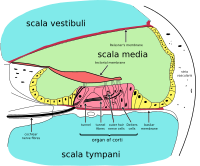
Photo from wikipedia
Objective To investigate the clinical features and factors affecting the prognosis of children with profound sudden sensorineural hearing loss (SSNHL). Methods We retrospectively analyzed the clinical data of 147 children… Click to show full abstract
Objective To investigate the clinical features and factors affecting the prognosis of children with profound sudden sensorineural hearing loss (SSNHL). Methods We retrospectively analyzed the clinical data of 147 children with profound SSNHL who received inpatient treatment at our department from January 2016 to January 2021. All children were administered with systemic steroid therapy and/or intratympanic steroid (ITS) treatment for 2 weeks. Statistical analyses were performed for the clinical features, treatment effectiveness, and factors affecting the prognosis using SPSS 23.0. Results The median age of the study population was 8 (6–10) years. The median treatment onset time was 8 (4–20) days. The most common concomitant symptom was tinnitus (45.58%). Laboratory findings showed that the percentages of children with abnormal leukocytes was 25.85%, abnormal platelet counts was 17.01%, abnormal cytomegalovirus IgG antibodies was 36.73% and abnormal Epstein–Barr (EB) virus IgG antibodies was 41.50%. The overall recovery rate of the treatment was 20.04%. The univariate analysis showed that age, treatment onset time, tinnitus, and ITS treatment were associated with the prognosis (p < 0.05). Regarding laboratory findings, the neutrophil count, lymphocyte count, and neutrophil-to-lymphocyte ratio differed significantly between the effective and invalid treatment effect groups (p < 0.05). The multivariable logistic regression analysis showed that treatment onset time [odds ratio (OR) = 0.936, 95% confidence interval (CI): 0.881–0.994] and ITS treatment (OR = 0.174, 95% CI: 0.044–0.0687) correlated with hearing recovery (p < 0.05). Conclusion In this study, the earlier the treatment start time of children with profound SSNHL, the better was the prognosis. Further, ITS could be an effective treatment option.
Journal Title: Frontiers in Pediatrics
Year Published: 2022
Link to full text (if available)
Share on Social Media: Sign Up to like & get
recommendations!